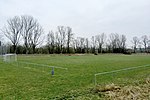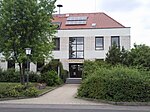Schweinfurt ( SHVYNE-foort, German: [ˈʃvaɪnfʊɐ̯t] ; lit. ''swine ford'') is a city in the district of Lower Franconia in Bavaria, Germany. It is the administrative centre of the surrounding district (Landkreis) of Schweinfurt and a major industrial, cultural and educational hub. The urban agglomeration has 100,200 (2018) and the city's catchment area, including the Main-Rhön region and parts of South Thuringia, 759,000 inhabitants.Schweinfurt was first documented in 791 and is one of the oldest cities in Bavaria. Around 1000 the Margraves of Schweinfurt controlled large parts of northern Bavaria. From the 12th century until 1802 Schweinfurt was a Free imperial city within the Holy Roman Empire, around 1700 a humanistic centre and in 1770 began the 250-year industrial history.
During World War II, the Americans suffered their biggest air defeat over Schweinfurt in the Second Raid on Schweinfurt (Black Thursday). On 11 April 1945, the US Army invaded the city. During the Cold War, the 1945 founded USAG Schweinfurt had the highest concentration of US combat units in the Federal Republic of Germany. In the northwest of Schweinfurt, an American town emerged, with a complete civil infrastructure including all kinds of shops for 12,000 Americans, soldiers and civilians. Until the withdrawal of the US Army at Schweinfurt in 2014, a total of about 100,000 US soldiers were stationed in the town.
Following German Reunification in 1990, Schweinfurt has become an important traffic hub in the centre of Germany. It has the highest employment density (2015) and the third highest gross domestic product per inhabitant of Germany (2014). The world's largest bearing group SKF, the second largest Schaeffler, the second largest automotive supplier in the world ZF Friedrichshafen and the DAX group Fresenius Medical Care have their largest plants in Schweinfurt.Some important inventions have their origin in Schweinfurt: the pedal bike by Philipp Moritz Fischer (1853) as well as the freewheel (1889) and the coaster brake (1903) by Ernst Sachs. In 1652, the oldest permanently existing natural-scientific academy in the world was founded in Schweinfurt, the German National Academy of Sciences Leopoldina.










